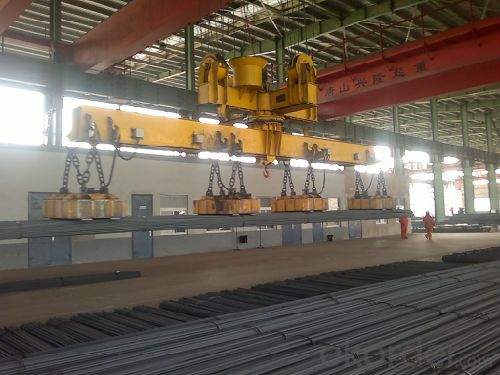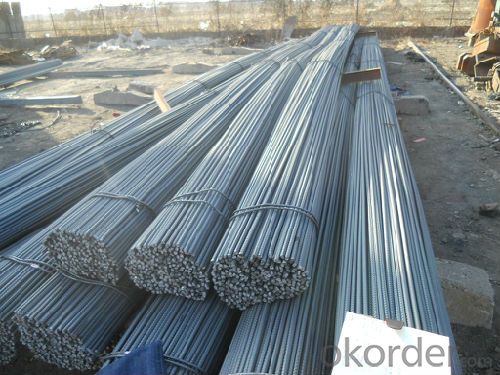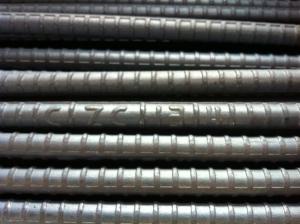GB Standard HRB335 Deformed Bars
- Loading Port:
- China Main Port
- Payment Terms:
- TT or LC
- Min Order Qty:
- -
- Supply Capability:
- -
OKorder Service Pledge
OKorder Financial Service
You Might Also Like
Product Description:
OKorder is offering GB Standard HRB335 Deformed Bars at great prices with worldwide shipping. Our supplier is a world-class manufacturer of steel, with our products utilized the world over. OKorder annually supplies products to African, South American and Asian markets. We provide quotations within 24 hours of receiving an inquiry and guarantee competitive prices.
Product Applications:
GB Standard HRB335 Deformed Bars are ideal for structural applications and are widely used in the construction of buildings and bridges, and the manufacturing, petrochemical, and transportation industries.
Product Advantages:
OKorder's GB Standard HRB335 Deformed Bars are durable, strong, and wide variety of sizes.
Main Product Features:
· Premium quality
· Prompt delivery & seaworthy packing (30 days after receiving deposit)
· Can be recycled and reused
· Mill test certification
· Professional Service
· Competitive pricing
Product Specifications:
Manufacture: Hot rolled
Grade: HRB335
Size: 6mm-25mm
Certificates: ISO, SGS, BV, CIQ
Length: 6m – 12m, as per customer request
Packaging: Export packing, nude packing, bundled
Grade | Technical data of the original chemical composition (%) | |||||||
C | Mn | Si | S | P | B | |||
HRB335 | ≤0.25 | ≤1.60 | ≤0.80 | ≤0.045 | ≤0.045 | >0.0008 | ||
Physics capability | ||||||||
Yield Strength(N/cm2) | Tensile Strength(N/cm2) | Elongation (%) | ||||||
≥335 | ≥490 | ≥16 | ||||||
FAQ:
Q1: Why buy Materials & Equipment from OKorder.com?
A1: All products offered byOKorder.com are carefully selected from China's most reliable manufacturing enterprises. Through its ISO certifications, OKorder.com adheres to the highest standards and a commitment to supply chain safety and customer satisfaction.
Q2: How do we guarantee the quality of our products?
A2: We have established an advanced quality management system which conducts strict quality tests at every step, from raw materials to the final product. At the same time, we provide extensive follow-up service assurances as required.
Q3: How soon can we receive the product after purchase?
A3: Within three days of placing an order, we will arrange production. The normal sizes with the normal grade can be produced within one month. The specific shipping date is dependent upon international and government factors, the delivery to international main port about 45-60days.
Images:


- Q:Can steel rebars be used in seismic-resistant construction?
- Yes, steel rebars can be used in seismic-resistant construction. Steel rebars are commonly used in reinforced concrete structures to enhance their strength and durability, making them suitable for withstanding seismic forces. By reinforcing the concrete with steel rebars, the structure becomes more resistant to the lateral and vertical movements caused by earthquakes, thereby improving the building's seismic performance.
- Q:How do steel rebars prevent cracks in concrete structures?
- Steel rebars prevent cracks in concrete structures by providing reinforcement and increasing the tensile strength of the concrete. When concrete is exposed to tensile forces, such as those caused by external loads or temperature changes, it tends to crack. However, steel rebars, which are embedded within the concrete, act as a reinforcement and absorb these tensile forces. The rebars distribute the load more evenly throughout the structure, preventing localized stress and minimizing the formation of cracks.
- Q:Can steel rebars be used in foundation construction?
- Yes, steel rebars can be used in foundation construction. They are commonly used to reinforce concrete foundations, providing strength and durability to the structure. The rebars are placed within the foundation to help prevent cracking and improve load-bearing capacity.
- Q:Are steel rebars suitable for use in high-temperature applications?
- High-temperature applications are generally not suitable for the use of steel rebars. Despite being a strong and durable material, steel has limitations when exposed to high temperatures. It can undergo a significant reduction in strength and even a loss of structural integrity, leading to potential failures. When subjected to high temperatures, steel goes through a process known as thermal expansion, which can weaken and deform it. This phenomenon is particularly noticeable in rebars, which are commonly used to reinforce concrete structures. The high temperatures cause the rebars to expand, exerting excessive pressure on the surrounding concrete. This pressure can result in cracks and potentially compromise the stability of the structure. Furthermore, prolonged exposure to high temperatures can cause a loss of the steel's mechanical properties, including its tensile strength and load-bearing capacity. As a result, the rebars become less effective in resisting external forces and reinforcing the concrete. For this reason, it is generally recommended to consider alternative materials, such as stainless steel or special alloys, for high-temperature applications. These materials are specifically designed to withstand elevated temperatures without compromising their structural integrity. To ensure safety and structural stability, it is important to consult with experts and engineers who are familiar with high-temperature applications in order to determine the most suitable materials for specific projects.
- Q:Can steel rebars be recycled after the demolition of a structure?
- After a structure is demolished, steel rebars can indeed be recycled. In fact, steel is widely recycled around the globe, and rebars are no exception to this trend. Typically, during the demolition process, rebars are separated from other materials like concrete and extracted from the structure. Subsequently, these rebars are gathered and transported to a recycling facility for further processing and melting. The molten steel can then be utilized to produce new rebars or other steel goods, thus decreasing the need for fresh steel production and preserving precious resources. By recycling rebars, not only do we help reduce waste and minimize environmental impact, but we also actively contribute to the circular economy by promoting material reuse.
- Q:Do steel rebars need to be coated with any protective materials?
- Yes, steel rebars commonly need to be coated with protective materials such as epoxy or galvanization to prevent corrosion and extend their lifespan.
- Q:What is the process of anchoring steel rebars in concrete?
- The process of anchoring steel rebars in concrete involves several steps to ensure a strong and secure bond between the rebar and the concrete. First, the concrete surface where the rebar will be anchored needs to be prepared. This typically involves cleaning the surface to remove any dirt, dust, or debris that could interfere with the bonding process. It is also important to ensure that the concrete is fully cured and has reached the required strength before proceeding. Next, the rebar is cut to the desired length and shape according to the construction plans. It is important to follow the specified dimensions and placement requirements to ensure proper reinforcement and structural integrity. After the rebar is prepared, it is usually placed in the desired position within the concrete formwork. The rebar should be positioned at the correct depth and spacing as specified by the design. This is typically accomplished by using plastic or metal chairs, spacers, or tie wire to hold the rebar in place. Once the rebar is properly positioned, the next step is to secure it to the concrete. One common method of anchoring the rebar is by using mechanical anchors or rebar couplers. These devices are designed to create a strong connection between the rebar and the concrete by utilizing various mechanisms such as threading, crimping, or expansion. Alternatively, another method of anchoring the rebar is by using adhesive or cementitious grouts. These materials are applied to the rebar and then inserted into pre-drilled holes in the concrete. The adhesive or grout helps to bond the rebar to the concrete and provides additional reinforcement. Finally, after the rebar is anchored, the concrete is poured or placed around it. The concrete should be properly consolidated to ensure that it fully surrounds and encases the rebar. This can be achieved through techniques such as vibrating the concrete or using specialized equipment. Overall, the process of anchoring steel rebars in concrete involves careful planning, preparation, and execution to ensure a reliable and durable bond between the rebar and the concrete. Following industry standards and design specifications is crucial to achieve the desired structural strength and integrity.
- Q:Can steel rebars be painted or coated for aesthetic purposes?
- Yes, steel rebars can be painted or coated for aesthetic purposes. The paint or coating helps enhance the appearance of the rebars and can also provide additional protection against corrosion.
- Q:What is the role of steel rebars in preventing concrete creep?
- The prevention of concrete creep relies heavily on the involvement of steel rebars. Concrete creep is the gradual movement or deformation of concrete over time when subjected to sustained load. This phenomenon occurs due to the long-term stress on the concrete, causing it to slowly deform and creep. To counteract this creep behavior, steel rebars, which are reinforced steel bars, are utilized in concrete structures. They play a significant role in preventing concrete creep by providing tensile strength and reinforcing the structure. When concrete is under a load, it experiences both compressive and tensile forces. While concrete can withstand compressive forces effectively, it is relatively weak in tension. This is where steel rebars come into action. By inserting steel rebars within the concrete, the tensile strength of the structure is greatly improved. Steel possesses high tensile strength, making it an ideal material for bearing the tension experienced by the concrete. As the concrete begins to creep under a sustained load, the steel rebars resist deformation and distribute the tensile forces throughout the structure. The presence of steel rebars restrains excessive deformation of the concrete, thus reducing the potential for long-term creep. By reinforcing the concrete with steel rebars, the structure becomes more resistant to creep and maintains its stability and integrity over time. Additionally, steel rebars enhance the overall durability and structural performance of the concrete. They improve the load-bearing capacity, prevent cracking, and enhance resistance against external forces like earthquakes or environmental factors. In conclusion, the significance of steel rebars in preventing concrete creep lies in their ability to provide tensile strength and reinforce the structure. They resist deformation of the concrete under sustained load, ensuring its stability and long-term integrity. The utilization of steel rebars greatly enhances the durability and structural performance of concrete structures, making them more resistant to creep and other potential issues.
- Q:Are steel rebars cost-effective compared to other reinforcement materials?
- Yes, steel rebars are generally considered cost-effective compared to other reinforcement materials. Steel rebars are widely available, durable, and have high tensile strength, making them suitable for various construction projects. Additionally, their longevity and low maintenance requirements contribute to their cost-effectiveness in the long run.
1. Manufacturer Overview |
|
|---|---|
| Location | |
| Year Established | |
| Annual Output Value | |
| Main Markets | |
| Company Certifications | |
2. Manufacturer Certificates |
|
|---|---|
| a) Certification Name | |
| Range | |
| Reference | |
| Validity Period | |
3. Manufacturer Capability |
|
|---|---|
| a)Trade Capacity | |
| Nearest Port | |
| Export Percentage | |
| No.of Employees in Trade Department | |
| Language Spoken: | |
| b)Factory Information | |
| Factory Size: | |
| No. of Production Lines | |
| Contract Manufacturing | |
| Product Price Range | |
Send your message to us
GB Standard HRB335 Deformed Bars
- Loading Port:
- China Main Port
- Payment Terms:
- TT or LC
- Min Order Qty:
- -
- Supply Capability:
- -
OKorder Service Pledge
OKorder Financial Service
Similar products
New products
Hot products
Related keywords





























